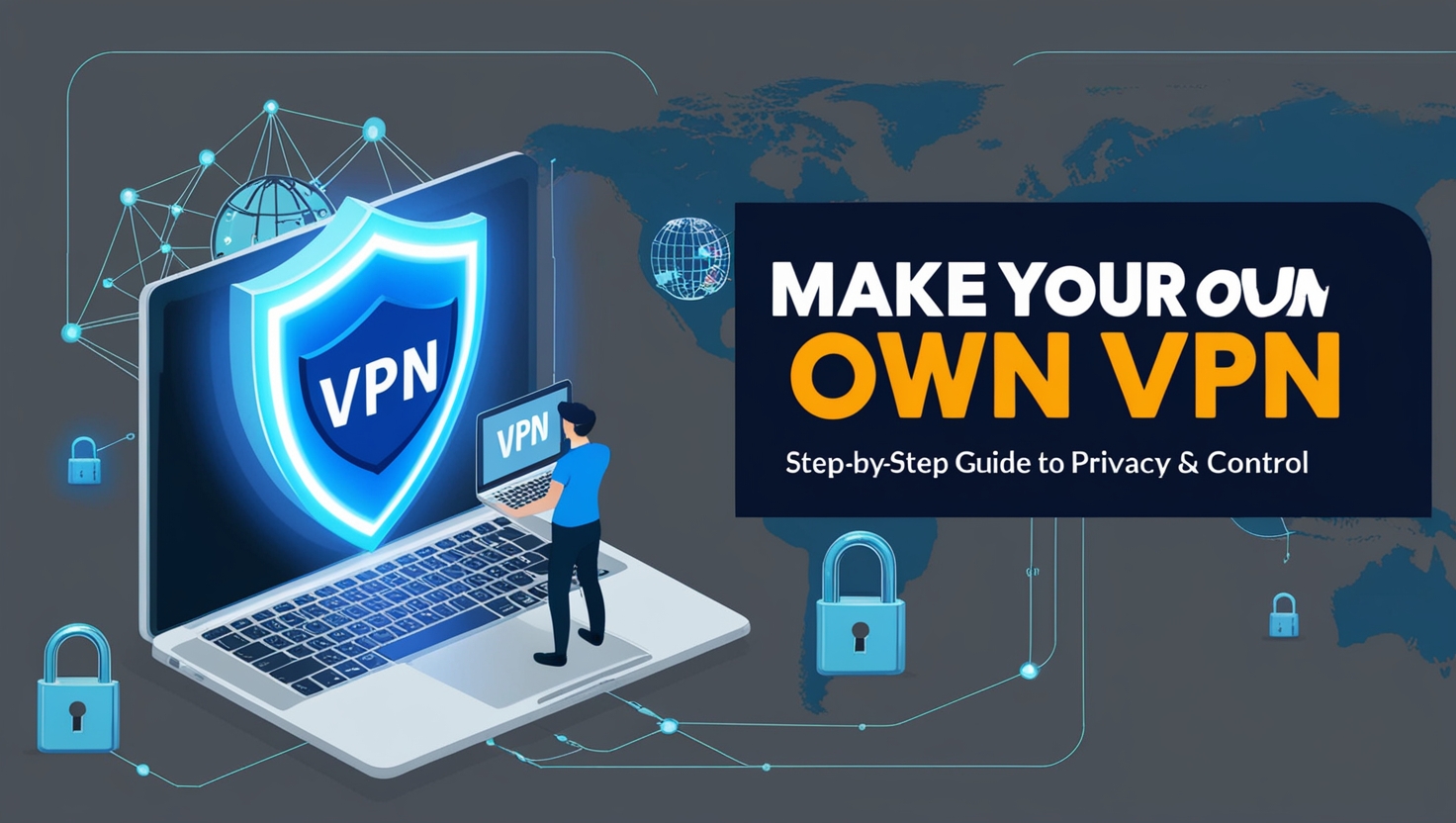🛡️ 1. What is a VPN and Why Should You Create Your Own?
A VPN (Virtual Private Network) is a secure tunnel between your device and the internet, ensuring encrypted data transfer and enhanced privacy. Most people use commercial VPN services, but did you know you can make your own VPN? Creating your own VPN gives you more control, transparency, and even cost benefits.
Unlike third-party services that may log your data or throttle your speeds, building your own VPN ensures you decide how your data is handled. This is especially critical in an age where privacy concerns are increasing.
🔍 2. Benefits of Building Your Own VPN
There are numerous reasons why people choose to make their own VPN instead of relying on commercial providers:
- Privacy & Security: You’re the only one with access. No third-party logs.
- Cost-Effective: VPS providers are cheaper in the long run.
- Unblocking Content: Access geo-restricted content by choosing the server’s location.
- Learning Opportunity: Gain hands-on experience in networking and cybersecurity.
- Speed Optimization: Fewer users mean faster, uninterrupted service.
🧰 3. What You Need Before You Start
Before you start the process to make your own VPN, ensure you have the following:
- A Virtual Private Server (VPS) or cloud service (e.g., DigitalOcean, Linode, AWS)
- Basic knowledge of Linux command-line
- A domain name (optional but helpful for DNS-based setups)
- SSH access to your server
- Stable internet connection on both server and client sides
These basics will help you confidently walk through the configuration and maintenance of your VPN server.
🌐 4. Choosing the Right VPS Provider for Your VPN
To make your own VPN, picking the right VPS provider is crucial. Here are some popular and reliable options:
- DigitalOcean – User-friendly, great documentation
- Vultr – Budget-friendly and globally distributed data centers
- Hetzner – Affordable European provider with strong performance
- Linode – Good customer support and simplicity
- AWS Lightsail – Ideal for advanced users and scalability
Ensure the VPS supports Ubuntu or Debian and allows root access.
🏗️ 5. Installing and Configuring Your VPN Server
This is where you make your own VPN technically. You can choose from multiple tools:
a. OpenVPN
One of the most popular VPN solutions:
wget https://git.io/vpn -O openvpn-install.sh
chmod +x openvpn-install.sh
sudo ./openvpn-install.sh
b. WireGuard
Faster and more lightweight than OpenVPN:
sudo apt install wireguard
Follow the official WireGuard documentation to set up the keys and configuration.
c. Algo VPN
An easy automation tool using Ansible that works with cloud providers:
git clone https://github.com/trailofbits/algo.git
cd algo
python3 -m virtualenv env && source env/bin/activate
🔐 6. Securing Your VPN for Maximum Privacy
Security is the foundation when you make your own VPN. Here are must-do security steps:
- Change default ports to avoid common attacks
- Set up UFW (Uncomplicated Firewall):
sudo ufw allow 51820/udp
sudo ufw enable
- Disable root SSH login and use key-based authentication
- Enable DNS leak protection
- Always keep the server updated:
sudo apt update && sudo apt upgrade
📲 7. Connecting Devices to Your VPN
Once the server is set up, configure your devices:
For OpenVPN:
- Import
.ovpnfile into apps like OpenVPN Connect (Android, iOS) or Tunnelblick (macOS).
For WireGuard:
- Use the official WireGuard app and scan the QR code generated during setup.
For Linux:
sudo openvpn --config your-config.ovpn
Make sure you test connectivity and set it to auto-connect on system startup.
🌍 8. Advanced Features to Add to Your VPN
Once you successfully make your own VPN, consider enhancing it:
- Kill switch to stop all internet traffic when disconnected
- Ad-blocking using DNS filtering tools like Pi-hole
- Split tunneling to allow selective routing
- Multihop VPN chaining for added anonymity
These features elevate your setup from basic to pro-level.
🧪 9. Testing Your VPN Setup
Test your VPN to ensure it works properly:
- Visit https://whatismyipaddress.com to verify IP masking
- Check DNS leaks using https://dnsleaktest.com
- Use
pingandtracerouteto analyze performance - Monitor logs in
/var/log/for any anomalies
Testing validates that you didn’t just make your own VPN—but did it right.
❗ 10. Common Issues and How to Troubleshoot Them
Even after setup, some issues might pop up:
- Can’t Connect? Recheck firewall rules or port forwarding.
- Authentication failed? Double-check credentials or certificates.
- Slow Speed? Consider switching protocols or server locations.
- DNS Leaks? Ensure DNS settings are routed through VPN.
Google error messages or check GitHub repositories for community support.
📘 11. Legal and Ethical Considerations of Running Your Own VPN
While it’s legal to make your own VPN in most countries, you must ensure it’s used ethically. Avoid:
- Torrenting copyrighted content
- Circumventing regional laws maliciously
- Hosting or transmitting harmful material
Understand data laws, especially if hosting in foreign countries.
✅ 12. Final Thoughts: Is Hosting Your Own VPN Worth It?
So, should you make your own VPN? Absolutely—if you care about privacy, learning, and control.
It might not have the bells and whistles of paid services, but the sense of ownership and transparency is unmatched. With minimal monthly costs and a solid understanding, you can build a VPN that serves your exact needs—safely, securely, and independently.

Leave a Reply